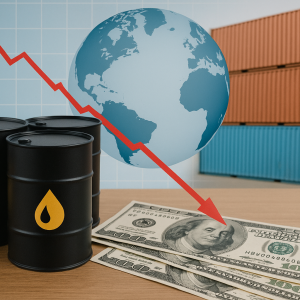Ciro Rapacciuolo
Share on
More obstacles than pushes. Italian GDP is expected to grow modestly in Q1 2025: services slow and industry slows down. Rate cuts continue but the wave of uncertainty generated by the continuing announcements on duties and the duties themselves are holding back trade and, with the instability of the financial markets, spending and investment decisions. The only positive side effect: the cost of energy falls.
Stock markets down. Sharp correction in equity markets in the US and Europe, triggered by the introduction of US duties, followed by partial recoveries in the last few trading days: -6.2% so far this month the S&P index, -8.8% the Italian FTSE. After the marked rise of 2023-2024, however, prices are still very high: in the US +83% from the 2019 average, in Italy +60%.
Cheaper energy. The price of gas in Europe (FTT) fell to €37/mwh on average in April, from €50 in February, while remaining well above the €14 in 2019; a similar decline for electricity (PUN), to €108/mwh in April, from €150 in February; and oil is also cheaper: 70 $/barrel, from 75. Inflation is expected to fall in Italy, after rising to +2.0% in March from +0.7% in September 2024, due to higher energy prices (+3.2% per year from -8.7%); the core is down (+1.5% from +1.8%).
Rates down. The ECB cut rates again in April (to 2.25%, from a peak of 4.00%), counting on inflation (net of energy) expected at target; markets expect the last cuts by 2025 and then the stop in 2026. The rate paid by Italian companies has already fallen to 3.99% in February, from 5.59%.
Investment is a concern. In March, confidence deteriorated for the second month, falling below the 2024 average. Economic policy uncertainty increased, dampening companies' investment choices. Judgments on the conditions for investing in Q1 2025 worsened compared to the end of 2024, both in services and construction, while they remained almost unchanged in industry.
Weak consumption. In Q4 2024 there was a downward correction in real household income (-0.6%), limiting the annual expansion to +1.2%; the savings ratio fell back to pre-pandemic values (8.5% from 9.1%), favouring consumption. Negative indicators at the beginning of 2025: retail sales remained flat in February (+0.1% food); household confidence fell in March.
More work. Employment growth continued in early 2025, despite the slowdown in economic activity. On a two-month basis, the number of employed persons grew by 1.0%, over 230,000, compared to Q4 2024. The decline in unemployment also continued. While the rise in the number of inactive persons should be read with caution, as it represents a reversal of the decline that had been evident since November 2024; however, monthly figures are often subject to revision.
Braking services. Tourism is off to a good start in 2025: spending by foreign travellers rose 7.1% annually in January. Negative, however, were the other indicators for services: in February, RTT (CSC-TeamSystem) reported a sharp decline in turnover in the sector; in March, the HCOB-PMI indicated a more moderate expansion (52.0 from 53.0); business confidence fell in each of the first three months of 2025.
Industry: risk of structural crisis with duties. Production fell in February (-0.9%), after a rebound in January (+2.5%). The change in Q1 is positive (+0.4%) after 5 quarters of decline. RTT indicates a deep decline in turnover in February, the PMI still reports a decline in March (46.6 from 47.4), confidence worsens. Duties will act negatively mainly on manufacturing.
Eurozone: industry stumbles in Spain. The change in manufacturing in Q1, as measured in February, indicated a slight recovery in Germany (+0.4%), a decline in France (-0.2%) and a contraction in Spain (-0.6%). The manufacturing PMI, negative in March for the entire Eurozone, confirmed this weakness, with Spain falling just below the expansion threshold for the second consecutive month.
Good US growth before the tariffs announcement. In March, industrial production fell (-0.3%), below expectations, but Q1 2025 closed with a marked improvement (+1.3%, from -0.3% in Q4 2024). Retail sales also rose sharply (+1.4%, from +0.2%), although the sharp decline in consumer confidence bodes well for a downturn in the coming months. The dynamics of employment improved greatly (+228 thousand in March, from +117 thousand).
China: effect frontload. In March, manufacturing accelerated to its fastest pace in four months, boosted by new orders, mainly from abroad. Exports posted an annual +12%, anticipating the entry into force of duties. Therefore, a slowdown in foreign demand is expected in the coming months, which will make the GDP growth target 'around +5%' challenging. China could aim for duty reduction by leveraging exports of strategic goods to the US (rare earths), which are now blocked.



Duties: strong impact on global and Italian growth.
Changing US duties. President Trump suspended the 'reciprocal' tariffs imposed on a large group of countries (at 20% for the EU) until 9 July. However, the tariffs of 10% remain in force, since 2 April, on most US purchases from abroad. Excluded for the time being are some strategic products (pharmaceuticals, copper and semiconductors, some minerals, energy) and some goods from Canada and Mexico. Conversely, all US purchases of steel and aluminium as well as motor vehicles and components (from 3 May) are affected by duties at 25%. Barriers between the US and China reached record levels: 145% on Chinese goods, 125% on US goods. Non-tariff barriers also increased: China stopped exports of rare earths and imports of Boeing. Overall, the increase in tariffs is estimated to be about 28% on US imports, higher than the Smoot-Hawley Act of 1930 (from 13% to 20%), which generated a world trade war.
Strong impact on the US economy. Tariffs are a tax levied on a substantial portion of US purchases of consumer, intermediate and investment goods (imports of goods account for 11.3% of GDP and 38.3% of industrial production): they push up prices and curb domestic demand. Uncertainty over US policies, at their highest, reduces traders' confidence and generates volatility in the financial markets. The price of gold, the ultimate safe haven asset, has risen by 21.7% so far in 2025 compared to 2024. The dollar depreciated by 5.6% against the euro in mid-April (from 1.08 to 1.14), amplifying the impact of imported inflation.
Stagnant world trade. High global economic policy uncertainty (+80% in 2025 over 2024) dampens business and investment activity of companies abroad. Expectations of lower global demand are also embedded in the recent drop in commodity prices. According to estimates by Centro Studi Confindustria, world trade is expected to stagnate in the two-year period 2025-2026 (-2.0/2.5 percentage points compared to spring forecasts), in the absence of further negative spirals in international financial markets. In addition, the substantial decoupling between the largest global importer (the US accounts for 13.1% of world imports in 2023) and the leading exporter (China accounts for 14.2% of exports) will lead to a profound recomposition of global supply chains, with a loss of efficiency and higher production costs.
Complex transmission channels to EU economies. Looking ahead, a collapse of Chinese shares in US imports (already at 13.3% in 2024, from 21.5% in 2017) may favour European sales, in a market that is, however, weak and more closed to foreign trade. Moreover, in the case of tariffs in 2018-2019 (Trump I), the biggest beneficiaries were other countries in Asia (Vietnam) and America (Mexico), also due to triangulation and production relocation strategies of Chinese exporters. Moreover, Chinese overproduction will be redirected to the rest of the world: safeguard and anti-dumping measures will be necessary in Europe to partially curb deflationary competitive pressure. Finally, the greatest risk, in the medium to long term, is the loss of production capacity in Europe through the shift of production steps to the United States.
Deep Italian connections. The US is the top non-EU destination for Italian goods, services and FDI. It holds primacy both as the location of Italian-controlled industrial companies and as the country of origin of multinationals in Italy. Manufacturing generates almost all of Italy's exports to the US, accounting for more than one-tenth of manufacturing sales abroad (10.8%). According to CSC estimates, sales to the US directly and indirectly generate almost 7% of Italian manufacturing output (approximately EUR 90 billion). The most exposed sectors are pharmaceuticals, motor vehicles, and machinery.
Impact on Italian growth. According to a CSC simulation, tariffs and uncertainty will cause lower growth of -0.3% in Italian GDP in 2025-2026, due to a lower dynamic of exports of goods (-1.2%) and investments in machinery (-0.4%). An EU tariff retaliation on purchases from the US should be avoided, which would impact prices and the confidence of households and businesses, further dampening GDP. Instead, it is crucial to conclude new EU trade agreements with other important economic partners (Mercosur, India).


































